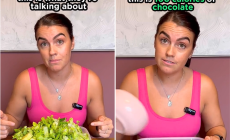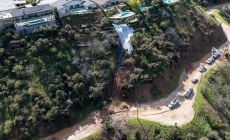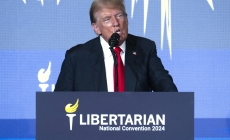-
Yo-Yo Dieter Reveals How She Managed to Lose Weight While Still Eating More - November 5, 2023
-
A portion of Mulholland Drive, damaged by mudslides in winter storms, reopens - May 26, 2024
-
‘Maybe You Don’t Want to Win’ - May 26, 2024
-
Donald Trump Putting Law Enforcement in Danger: Attorney - May 25, 2024
-
Avoid the waters of these 5 L.A. County beaches this holiday weekend, public health officials say - May 25, 2024
-
Bawdy Comedy ‘Anora’ Wins Palme d’Or at Cannes Film Festival - May 25, 2024
-
Map Shows Heat Wave Zone Spread Into Five New States - May 25, 2024
-
Azusa police arrest suspected slingshot-wielding vandal - May 25, 2024
-
Donald Trump Hammers Judge Ahead of Jury Instructions - May 25, 2024
-
Sometimes U.S. and U.K. Politics Seem in Lock Step. Not This Year. - May 25, 2024
Yo-Yo Dieter Reveals How She Managed to Lose Weight While Still Eating More
Losing weight doesn’t have to mean giving up on generous portions of food, says Emmaline Howard.
The 27-year-old wellness coach told Newsweek that she constantly chased “unsustainable and unhealthy fad diets or yo-yo dieting”, which led to her weight rising to 75 kilograms (165 pounds) before plummeting to 55 kilograms (120 pounds) in just over a year.
Howard was unhappy at her heaviest and lightest, and at everything in between. Eventually, the coach came to the realization that crash dieting wasn’t doing her any favors.
The coach claims that it’s entirely possible to eat generous portions of food while still losing weight.

@CoachEmmaline
It’s this approach to food that Howard says helped her overcome the binge eating habits that tormented her for years, before she finally embarked on the “health journey” two years ago that she cites as being what “healed” her “relationship with food”.
“This is what I want to teach people to avoid. I wasn’t happy at 75kg or 55kg, because it was never about the scales! It was about how I spoke to myself and how society made me feel,” Howard told Newsweek.
Now she’s 66 kilograms (145 pounds), the same weight she was when she started making lifestyle changes, and describes herself as being the happiest she’s ever been.
In a social media post that can be seen here, the coach turned content creator walked her digital audience through how to eat generous portions of nourishing food while still losing weight, all by favoring volume foods. The post has been viewed over 1.4 million times across Instagram and TikTok since October 4.
Volume foods are low-calorie foods that take up stomach space and leave you feeling fuller for longer. These foods usually come at a higher volume due to the levels of liquid, fiber or air that they’re comprised of.
“Do you know how to eat so that you’re actually full? When you’re not hungry all the time, it makes fat loss easier,” Howard shared with her digital audience.
“Your stomach is only a certain size. So, the idea is to eat foods that take up a lot of space for not many calories so that your stomach is full and you’re not hungry,” she added.
I wasn’t happy at 75kg or 55kg, because it was never about the scales.
Emmaline Howard
The creator proceeded to show off how an enormous portion of lettuce amounts to only 100 calories, while a measly portion of chocolate is the same figure.
While Howard isn’t encouraging her followers to give up desserts, she intends to show that weight loss and health journeys don’t just come down to restrictive eating.
The coach says that eating less doesn’t always amount to achieving your fitness goals because what you eat is more important than how much of it you eat. Still, Howard believes in the importance of balance and in treating yourself every now and then.
“I’m not saying that you shouldn’t eat high-calorie foods, just include volume foods too and your fat loss goals will be easier to achieve,” the coach added at the foot of her post.
The Centers for Disease Control and Prevention says online that healthy weight isn’t just about following a diet. Instead, it involves a lifestyle with healthy eating patterns, regular physical activity, and stress management.

@CoachEmmaline
Howard’s Battle With Eating Disorders
“I became a coach because I wanted to help people not feel alone in their health journeys,” Howard told Newsweek.
“I’ve battled eating disorders and it’s very isolating when you feel like no one understands what’s going on inside your head. As a consequence of my poor relationship with food, I yo-yo dieted and ended up being thin all the way to being overweight.”
“I’ve battled severe body issues and struggled to find helpful information. I worked on my relationship with food and with myself and that’s when everything changed,” she added.
The coach heard about volume foods while feeling low, and began experimenting with the concept by introducing low-calorie foods into her diet.
“I want to show people what volume foods are and how they take up plenty of stomach space while being low-calorie. So, while you’re enjoying a large quantity of food, you’re not using up many of your daily calories,” Howard explained.
“You end up feeling full because your stomach is full of food, and you get to eat a larger quantity of food,” she added.
Experts’ Verdicts on Volume Foods
Registered dietitian and nutritionist, Avery Zenker, doesn’t dispute Howard’s claims about the connection between volume foods and weight loss. She adds that there are more ways to feel fuller for longer instead of just resorting to large lightweight meals.
“Nutrient-dense volume foods provide essential vitamins, minerals and antioxidants. However, our bodies have different satiety cues to let us know when we’re full, including stretch receptor and satiety hormones like leptin,” the EverFlex Fitness dietitian told Newsweek.
“Three key components to focus on for fullness are protein, fiber, and fluid. Protein helps us feel satiated. Fiber and fluid take up stomach space without adding calories which stimulates our stomach’s stretch receptors to initiate fullness,” she said.
Zenker outlined to Newsweek that this is why high fiber diets, and diets rich with whole fruits, help us feel fuller for longer.
“Mindful eating is also important to feel full,” Zenker added.
 You will find more infographics at Statista
You will find more infographics at StatistaWhen chewing meals thoroughly and minimizing the distractions around the dinner table we eat at a slower pace, which can help us feel satiety signals and conclude that we’re full.
“A balanced meal with protein, carbohydrates, fiber, and fats should help us feel full too,” she explained.
Newsweek also consulted dietitian and nutritionist Rachael Richardson for her take on volume foods.
“They tend to be deemed ‘safer’ low-calorie foods, so [eating disorder] patients have less fear associated with them than high-calorie foods and may be encouraged to add them into their diet,” Richardson added.
Despite her championing volume foods, Howard stated there are multiple factors to consider when embarking on a health journey.
She has comforting words for those eager to start, reminding people to consider their physical and mental health first.
“My motto is always ‘small wins equal big change’. Keep looking for small wins daily and they’ll add up. It’s overwhelming when you first start, so don’t try to do everything all at once.
“Simple things like going for a walk or including slightly more fruit and veg in your day are all great. You don’t need a whole new diet, you just need to make small improvements,” Howard said.
Is there a health issue that’s worrying you? Let us know via health@newsweek.com. We can ask experts for advice, and your story could be featured on Newsweek.
Uncommon Knowledge
Newsweek is committed to challenging conventional wisdom and finding connections in the search for common ground.
Newsweek is committed to challenging conventional wisdom and finding connections in the search for common ground.
Source link
































